Twoja witryna WordPress nie wysyła e-maili. Przesyłane formularze kontaktowe znikają, a ważne powiadomienia nigdy nie są importowane. Brzmi znajomo?
Nie jesteś sam, a problem nie leży w samym WordPressie. Jest nim sposób, w jaki witryny internetowe zazwyczaj obsługują dostarczanie wiadomości e-mail.
Dokładnie z tym problemem mieliśmy do czynienia na WPBeginner. Dlatego używamy i ufamy WP Mail SMTP do obsługi wszystkich naszych e-maili WordPress. Wykorzystuje on SMTP (standard branżowy dla niezawodnego dostarczania e-maili), aby upewnić się, że twój e-mail faktycznie dotrze do miejsca przeznaczenia.
W tym przewodniku pokażemy dokładnie, co powoduje twoje problemy z e-mailem i jak je naprawić za pomocą SMTP, abyś nigdy nie przegapił kolejnego ważnego powiadomienia.
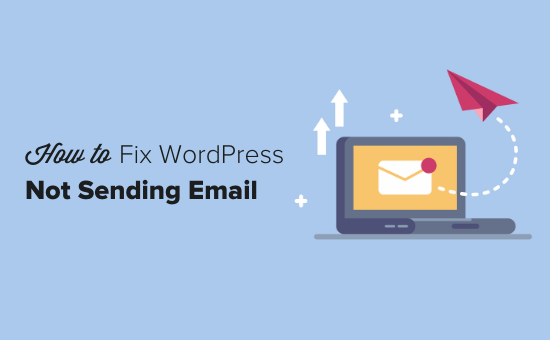
Dlaczego twoja witryna WordPress nie otrzymuje e-maili?
Najczęstszą przyczyną braku e-maili jest to, że twój serwer hostingowy WordPress nie jest poprawnie skonfigurowany do korzystania z funkcji PHP mail().
Nawet jeśli twój hosting jest skonfigurowany do korzystania z niego, wielu dostawców usług e-mail, takich jak Gmail i inni, korzysta z różnych narzędzi w celu ograniczenia spamu e-mail. Narzędzia te próbują wykryć, czy e-mail pochodzi z lokalizacji, za którą się podaje.
E-maile wysyłane przez witryny internetowe WordPress często nie przechodzą tego testu.
Oznacza to, że gdy e-mail jest wysyłany z twojej witryny WordPress (z wtyczki formularza kontaktowego, powiadomienia administratora itp.), może nawet nie trafić do katalogu spamu odbiorcy, nie mówiąc już o skrzynce odbiorczej.
Dlatego zalecamy, aby nie używać WordPressa do wysyłania twojego newslettera e-mail.
Jest to również powód, dla którego zalecamy wszystkim korzystanie z SMTP do wysyłania e-maili w WordPress.
Co to jest SMTP?
SMTP (Simple Mail Transfer Protocol) to branżowy standard wysyłania wiadomości e-mail.
W przeciwieństwie do funkcji PHP mail(), SMTP używa odpowiedniego uwierzytelniania, co prowadzi do wysokiej dostarczalności e-maili.
WordPress posiada wtyczkę WP Mail SMTP, która konfiguruje twoją witrynę WordPress do wysyłania e-maili za pomocą SMTP zamiast funkcji PHP mail().
Można go używać do łączenia się z dowolnymi popularnymi usługami SMTP, takimi jak SendLayer, Brevo (dawniej Sendinblue), Gmail (Google Workspace), Amazon SES i inne.
Możesz przeczytać naszą recenzję WP Mail SMTP, jeśli potrzebujesz więcej szczegółów na temat wtyczki.
Mając to na uwadze, przyjrzyjmy się, jak poprawić problem niewysyłania e-maili przez WordPress. Możesz skorzystać z poniższych odnośników, aby poruszać się po tym artykule:
Alternatywa: Jeśli korzystasz z WooCommerce i twoje e-maile z zamówieniami nie są dostarczane, to zamiast tego przeczytaj nasz przewodnik o tym, jak poprawić WooCommerce nie wysyła e-maili z zamówieniami.
Krok 1: Zainstalowanie wtyczki WP Mail SMTP
Niezależnie od wybranej usługi SMTP, musisz mieć zainstalowaną wtyczkę WP Mail SMTP na twojej witrynie. Umożliwia ona przełączenie WordPressa z korzystania z wbudowanej funkcji PHP mail() na korzystanie z twojej usługi SMTP.
Najpierw zainstaluj i włącz wtyczkę WP Mail SMTP. Jeśli nie wiesz jak to zrobić, zapoznaj się z naszym przewodnikiem krok po kroku, jak zainstalować wtyczkę WordPress.
Następnie kliknij “WP Mail SMTP” w twoim kokpicie WordPress, aby skonfigurować ustawienia wtyczki.
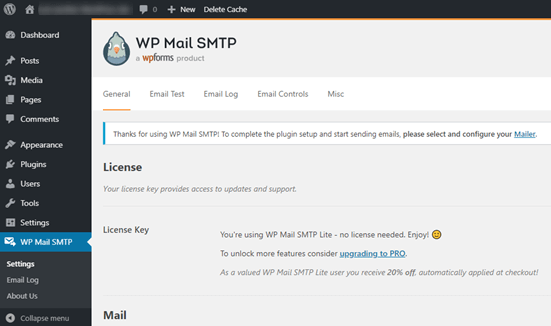
Będziesz musiał zacząć od wpisz nazwę i biznesowy adres e-mail, z którego mają pochodzić wiadomości e-mail z Twojej witryny.
Upewnij się, że używasz tutaj tego samego adresu e-mail, który będzie używany dla twojej usługi mailingowej SMTP.
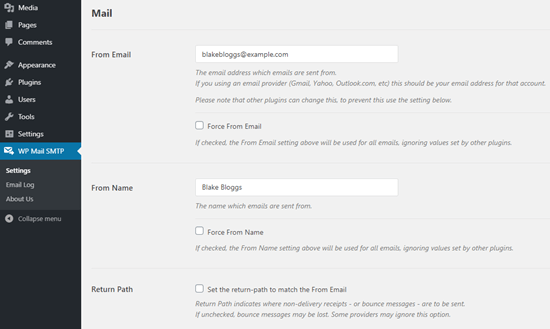
Możesz wymusić, aby e-maile używały tej nazwy i adresu e-mail, nawet jeśli inne wtyczki, takie jak WPForms, mają inne ustawienia. WP Mail SMTP zastąpi ustawienia innych wtyczek.
Następnie należy wybrać usługę pocztową SMTP dla twojej witryny. W tym poradniku skonfigurujemy SMTP za pomocą SendLayer.
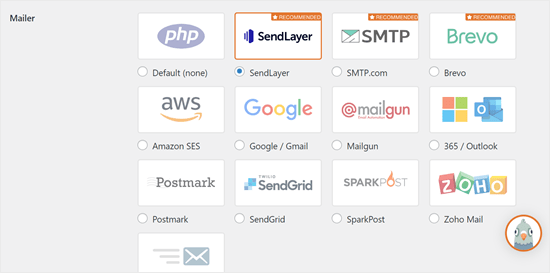
Aby zakończyć konfigurację WP Mail SMTP, musisz utworzyć konto w SendLayer. Przejdziemy do tego w następnej kolejności, a następnie wrócimy do finalizowania konfiguracji WP Mail SMTP, więc pamiętaj, aby pozostawić tę kartę otwartą.
Krok 2: Skonfiguruj twoją usługę pocztową SMTP
SendLayer to niezawodny dostawca usług e-mail. Pozwala na wysyłanie dużej liczby e-maili z wysoką dostarczalnością.
Możesz użyć SendLayer do wysłania do 200 e-maili za darmo, co jest więcej niż wystarczające dla większości małych witryn internetowych, aby rozpocząć.
Mogą to być e-maile z formularza kontaktowego, dane nowego konta użytkownika, e-maile dotyczące odzyskiwania hasła lub inne wiadomości e-mail wysyłane za pośrednictwem Twojej witryny WordPress.
Najpierw musisz przejść do witryny internetowej SendLayer, aby utworzyć konto. Na stronie z cennikiem kliknij odnośnik “Wypróbuj bezpłatną wersję próbną SendLayer (wyślij do 200 e-maili)”, aby skonfigurować twoje konto.
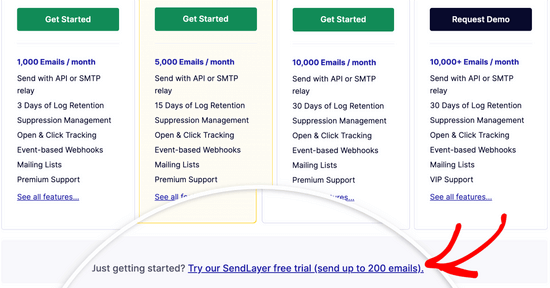
Po utworzeniu konta zobaczysz swój kokpit SendLayer.
Teraz, gdy masz już konto SendLayer, skonfigurujmy twojego dostawcę e-mail z WordPress.
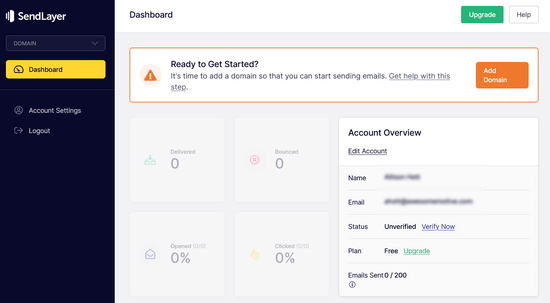
Krok 3: Połącz twoją witrynę internetową WordPress z SendLayer
Zanim będziesz mógł wysyłać e-maile za pomocą SendLayer, musisz autoryzować swoją domenę.
Dowodzi to serwerom e-mail, że jesteś potwierdzonym właścicielem domeny wysyłającej i że twoje wiadomości e-mail są wysyłane z legalnego źródła.
Aby autoryzować twoją domenę, kliknij pomarańczowy przycisk “Dodaj domenę” na kokpicie SendLayer.
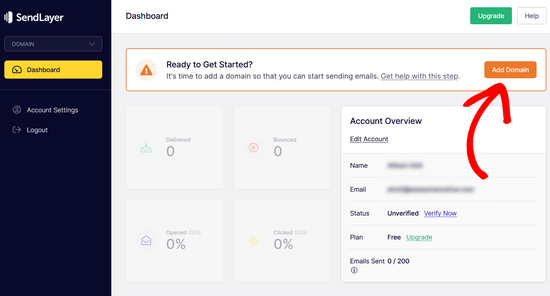
Na następnej stronie wystarczy wpisać nazwę twojej domeny w odpowiednie pole.
Następnie kliknij przycisk “Dodaj domenę”.
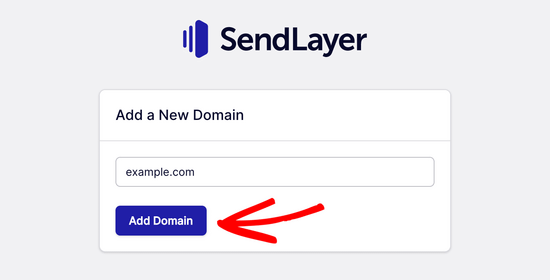
Uwaga: W przypadku innych usług mailingowych, takich jak Brevo (dawniej Sendinblue), musisz najpierw skonfigurować subdomenę dla twojej witryny internetowej. SendLayer automatycznie doda subdomenę do rekordów DNS domeny nadawcy.
Nie trzeba więc dodawać dodatkowej subdomeny podczas rejestracji domeny.
Po dodaniu Twojej domeny, SendLayer pokaże Ci 5 rekordów DNS, które musisz dodać do ustawień rekordów DNS Twojej domeny.
Te linie kodu pozwalają SendLayer autoryzować twoją nazwę domeny.
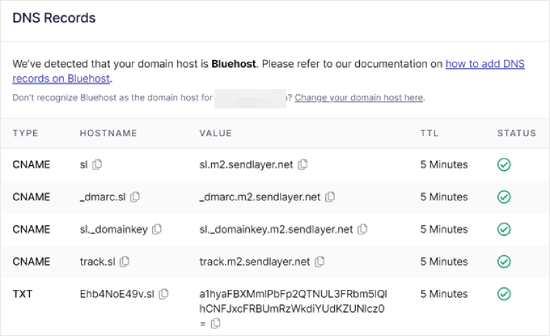
Będziesz musiał dodać te rekordy DNS do swojej witryny WordPress. Może się to wydawać skomplikowane, ale wystarczy je skopiować i wkleić w odpowiednie miejsce.
Na potrzeby tego poradnika zademonstrujemy nasz przykład na przykładzie konta hostingowego w Bluehost.
Jeśli korzystasz z usług innych firm hostingowych lub Twój DNS jest zarządzany przez rejestratora domen, takiego jak Domain.com, Network Solutions lub GoDaddy, postępuj zgodnie z ich instrukcjami.
Możesz również przeczytać nasz przewodnik, jak skonfigurować WP Mail SMTP z dowolnym hostem.
Najpierw otwórz nową kartę przeglądarki i loguj się na swoje konto hostingowe WordPress. Następnie znajdź rekordy DNS twojej domeny.
W Bluehost można to zrobić, przechodząc do sekcji “Domeny”. Następnie kliknij “Ustawienia” obok domeny, którą chcesz połączyć z SendLayer.
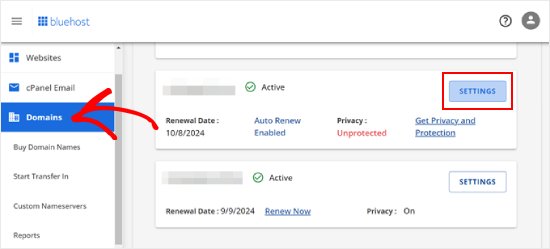
Na następnej stronie przewiń w dół do sekcji “Narzędzia zaawansowane”.
Następnie kliknij przycisk “Zarządzaj” obok pozycji Zaawansowane rekordy DNS.
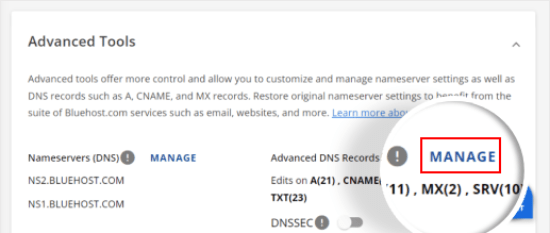
Pojawi się komunikat ostrzegawczy z informacją, że rekordy DNS powinny być edytowane przez zaawansowanego użytkownika. Nie przejmuj się tym komunikatem, ponieważ proces ten jest dość prosty.
Przejdź dalej i kliknij “Kontynuuj”, aby kontynuować.
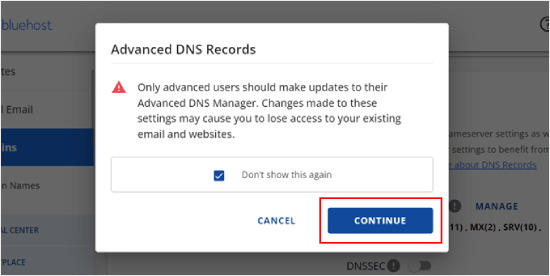
Zostanie wyświetlona strona Manage Advanced DNS Records (Zarządzaj zaawansowanymi rekordami DNS).
Aby rozpocząć, kliknij przycisk “+ Dodaj rekord”.
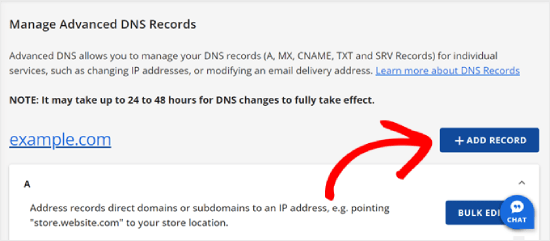
Teraz zacznijmy dodawać rekordy DNS, które dostarczył SendLayer.
Najpierw należy wybrać rodzaj rekordu DNS. W tym przypadku użyjemy CNAME dla pierwszego rekordu.
W sekcji “Odnosi się do” kliknij “Inny host”. Tę samą opcję wybierzesz później dla wszystkich twoich rekordów DNS.
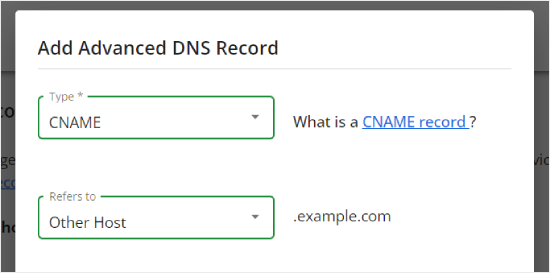
Przewijając w dół, zobaczysz trzy pola: Nazwa hosta, Alias i TTL.
Nazwa hosta powinna być wypełniona wartością w ‘Hostname’ dostarczoną przez SendLayer. Alias powinien być wypełniony wartością w “Value”. Jeśli chodzi o TTL, możesz pozostawić go na 15 minut.
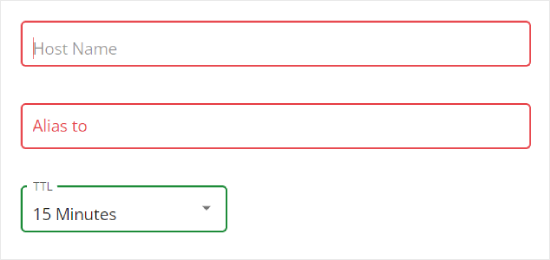
Poniższy zrzut ekranu pokazuje, jak wyglądał nasz ekran po dodaniu pierwszego rekordu CNAME.
Po zakończeniu kliknij “Dodaj”.
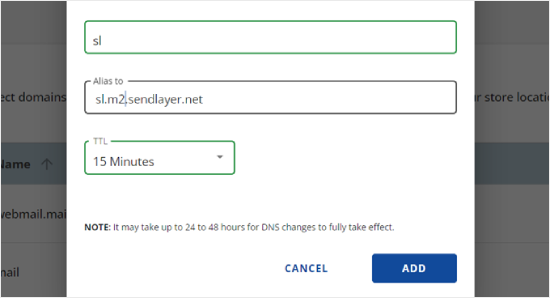
Kroki te można powtórzyć dla wszystkich rekordów DNS (zarówno CNAME, jak i TXT).
Podczas dodawania rekordu TXT należy wkleić wartość “Hostname” z SendLayer do pola “Host Name”, a wartość z “Value” do pola “TXT Value”.
Oto jak to wygląda:
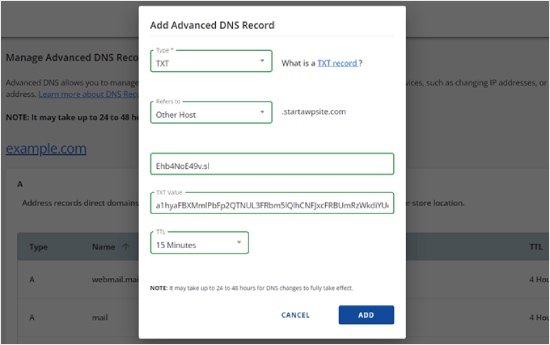
Po dodaniu twoich rekordów, wróć do SendLayer i zaznacz pole obok “Dodałem te rekordy DNS i jestem gotowy do kontynuowania”.
Następnie kliknij przycisk “Zweryfikuj rekordy DNS”.
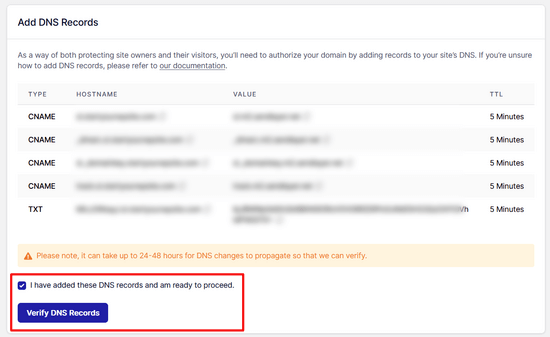
Może minąć 24-48 godzin, zanim SendLayer będzie w stanie zweryfikować twoje dane. Z naszego doświadczenia wynika, że zajęło to kilka godzin.
Jeśli po kliknięciu tego przycisku nic się nie dzieje, rekordy nie mogą być jeszcze zweryfikowane. Możesz sprawdzić ponownie później, aby zobaczyć, czy zostały zweryfikowane, przechodząc do “Ustawień” i przechodząc do karty “Rekordy i ustawienia DNS” z kokpitu SendLayer.
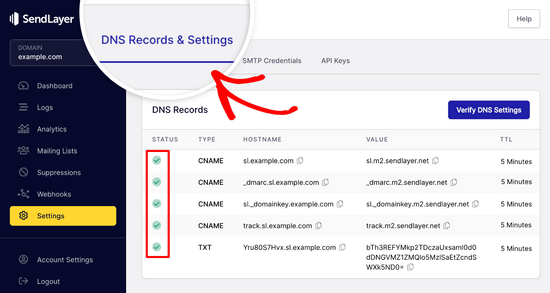
Tutaj znajdziesz listę wszystkich twoich rekordów DNS w jednym miejscu. Gdy twoja domena zostanie pomyślnie autoryzowana, zobaczysz zielone znaczniki wyboru obok każdego rekordu DNS w kolumnie “Status”.
Możesz kontynuować korzystanie z tego poradnika, czekając na autoryzację.
Krok 4: Zakończenie konfiguracji WP Mail SMTP do korzystania z SendLayer
Zakończmy konfigurację. Najpierw przejdź do twojego konta SendLayer, aby znaleźć klucz API.
Z kokpitu SendLayer wystarczy przejść do strony Ustawienia “ Klucze API. Tutaj zobaczysz domyślny klucz API, który został wygenerowany podczas autoryzacji Twojej domeny w SendLayer.
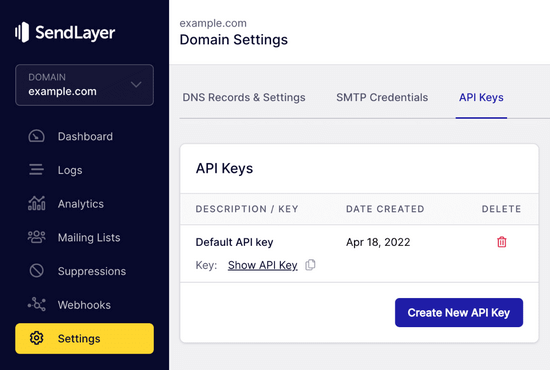
Klucz API można skopiować z tej strony, klikając ikonkę kopiowania.
Na przykład:
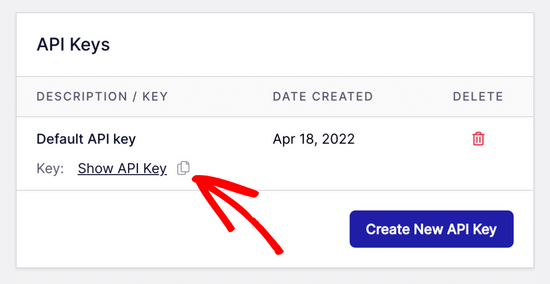
Po wykonaniu tej czynności możesz wrócić do karty kreatora konfiguracji WP Mail SMTP.
Następnie wklej klucz API w odpowiednim miejscu.

Gratulacje. Wszystko zostało już skonfigurowane. Ostatnim krokiem jest wysłanie testowego e-maila, aby upewnić się, że wszystko działa.
Przejdź do WP Mail SMTP “ Narzędzia. W karcie “Test e-mail” wpisz adres e-mail, na który chcesz wysłać wiadomość e-mail. Domyślnie będzie to e-mail administratora witryny. Kliknij “Wyślij e-mail”.
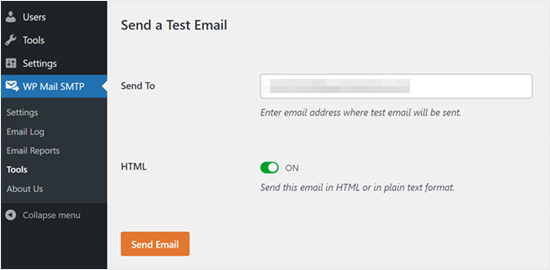
Powinieneś zobaczyć komunikat “Testowy e-mail HTML został wysłany pomyślnie!”.
Sprawdź swoją skrzynkę odbiorczą, aby sprawdzić, czy wiadomość dotarła. Będzie wyglądać następująco:
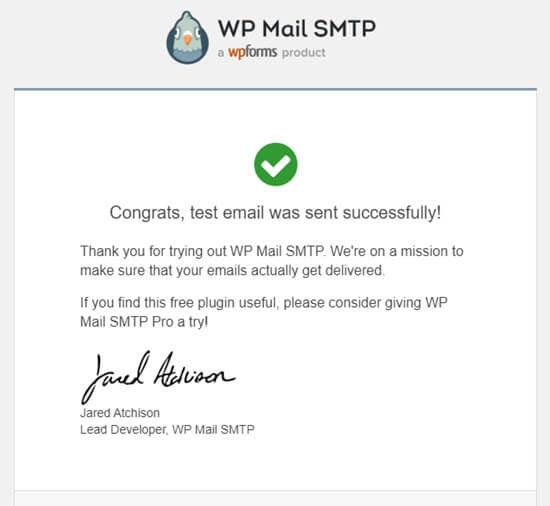
Uwaga: Jeśli twoje konto SendLayer nie jest jeszcze włączane, otrzymasz komunikat: [permission_denied]: Nie można wysłać e-maila. Twoje konto SMTP nie jest jeszcze włączane.
Alternatywne sposoby na naprawienie problemu z niewysyłaniem e-maili przez WordPressa
Jak widać z listy opcji usług pocztowych wtyczki WP Mail SMTP, nie trzeba korzystać z SendLayer. Chociaż jest to nasza najlepsza darmowa rekomendacja, istnieją inne opcje, z których można skorzystać, w tym Microsoft 365, GoogleWorkspace, Amazon SES itp.
Używanie Gmaila lub Google Workspace z WP Mail SMTP do poprawki e-maili z WordPressa
Jeśli masz Gmaila, możesz go używać do wysyłania twoich e-maili. Nie będziesz musiał wpisz swoje dane logowania e-mail w WordPress, gdy używasz wtyczki WP Mail SMTP.
Aby korzystać z Gmaila lub Google Workspace, skonfiguruj WP Mail SMTP, jak pokazano powyżej, a następnie kliknij opcję “Google / Gmail” dla twojej usługi pocztowej.
Następnie można skonfigurować ustawienia usługi pocztowej za pomocą konfiguracji WP Mail SMTP jednym kliknięciem.
Ta metoda nie wymaga tworzenia twojej własnej aplikacji, co jest znacznie łatwiejsze. Wystarczy zalogować się na twoje konto Gmail i kliknąć “Zapisz ustawienia”.
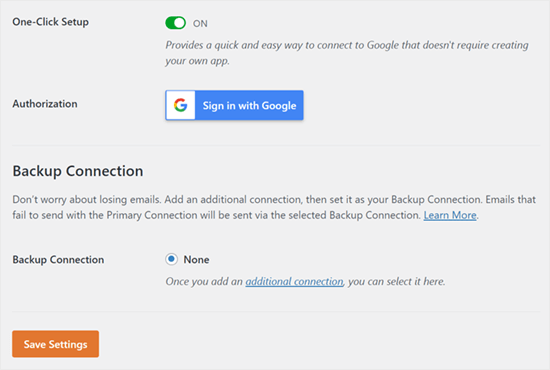
Korzystanie z Twojego profesjonalnego Gmaila lub Google Workspace ma jednak kilka kluczowych wad.
Jednym z nich jest konieczność skontaktowania się z twoim hostingiem w celu zainstalowania odpowiedniego certyfikatu.
Innym jest to, że jeśli zmienisz adres e-mail w przyszłości, będziesz musiał ponownie przejść przez cały proces. Obejmuje to utworzenie nowej aplikacji internetowej.
Używanie Microsoft 365 z WP Mail SMTP do poprawki e-maili WordPressa
Jeśli korzystasz z Microsoft Office 365 lub Outlook dla twojego zwykłego konta e-mail, możesz również użyć go do wysyłania e-maili za pośrednictwem WordPress. Nie jest to jednak zalecana opcja, ponieważ jest mniej bezpieczna.
Będziesz musiał skonfigurować WP Mail SMTP jak powyżej, a następnie kliknąć opcję “365 / Outlook” przy wyborze twojej usługi pocztowej SMTP. Następnie należy zarejestrować aplikację na Microsoft Azure, aby móc wypełnić poniższe pola.
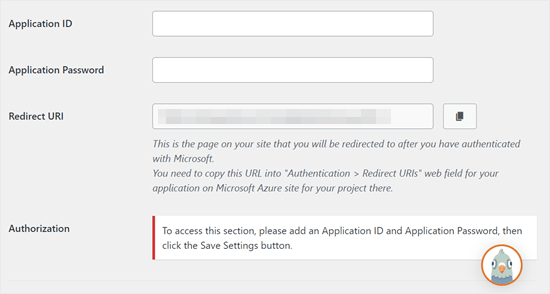
Więcej szczegółów można znaleźć w szczegółowym przewodniku na temat konfiguracji Outlooka z WP Mail SMTP.
Używanie Amazon SES z WP Mail SMTP do poprawki e-maili WordPressa
Platforma Amazon AWS posiada usługę Simple Email Service (SES), której można użyć do poprawienia problemu z e-mailem WordPress.
Najlepszą częścią Amazon jest to, że pozwala wysyłać do 62 000 e-maili miesięcznie za darmo. Wadą jest to, że konfiguracja jest nieco trudniejsza dla początkujących, dlatego nie polecamy jej jako preferowanej opcji.
Ale jak można sobie wyobrazić, wielu profesjonalistów i ekspertów korzysta z Amazon SES dla swojej usługi SMTP e-mail WordPress, więc nie mogliśmy napisać artykułu bez wspomnienia o nim.
Jeśli jesteś zainteresowany konfiguracją Amazon SES z WordPress, zapoznaj się z pełną instrukcją konfiguracji Amazon SES z WordPress.
Bez względu na to, z jakiej usługi pocztowej zdecydujesz się skorzystać, zawsze pamiętaj o użyciu funkcji “Testuj e-mail”, aby upewnić się, że wiadomości e-mail są pomyślnie wysyłane.
Musisz również sprawdzić swoją skrzynkę odbiorczą i potwierdzić, że otrzymałeś testowego e-maila.
Film instruktażowy
Jeśli wolisz instrukcje wizualne, obejrzyj ten film:
Doświadczasz innych błędów WordPress? Sprawdź te przewodniki
WordPress nie jest doskonały i od czasu do czasu możesz napotkać pewne typowe błędy. Oto kilka poradników, które możesz sprawdzić, aby je rozwiązać:
- Jak naprawiono niedziałający przycisk dodawania multimediów w WordPress?
- Jak naprawić problem z przesyłaniem obrazków w WordPress (krok po kroku)
- Jak naprawiono błąd mieszania treści w WordPress (krok po kroku)
- Jak naprawić wpisy WordPress zwracające błąd 404 (krok po kroku)
- Jak naprawić błąd “WordPress Database Error Disk Full”?
- Jak naprawiono błąd nawiązywania połączenia z bazą danych w WordPress?
- Jak poprawić błąd “Przepraszamy, ten rodzaj pliku nie jest dozwolony ze względów bezpieczeństwa” w WordPress?
- Jak naprawiono błąd 502 Bad Gateway w WordPress?
- Jak naprawiono niedziałającą wyszukiwarkę WordPress?
- Formularz WordPress nie działa: 7 wskazówek dotyczących rozwiązywania problemów
Mamy nadzieję, że ten artykuł pomógł ci dowiedzieć się, jak poprawić problem z niewysyłaniem e-maili przez WordPress. Możesz również zapoznać się z naszą listą najczęstszych problemów z edytorem bloków WordPress lub naszymi najlepszymi wtyczkami do konfiguratora e-mail WooCommerce.
If you liked this article, then please subscribe to our YouTube Channel for WordPress video tutorials. You can also find us on Twitter and Facebook.





Will
My problem is that wordpress won’t send emails to or from an address that is coming from my domain name. E.g. @domain.com. But it will send from any other email address type.
Md Sajid
i successfully setup my site, and it is working very well.
thanks for this nice and working tutorial..
i used gmail api first method..
SORRY FOR MY BAD ENGLISH
idayat
hello, please does anyone know how can stop WordPress from sending automatic emails to blog subscribers, i want to use MailChimp but it seems i have to first disable WordPress. thank you
Lyndsay
Great instructions! Clear, easy to follow and they work!
Iman
Thank you so much. You have tutorial helped me fix my email problem . this was one of the best tutorials I have ever seen. every step is very well explained.
alex
Hi, I have installed SMTP – I think right.. but I’m still not receiving emails from the contact form. I’m also not getting new order notifications. can someone please help me?
Sagar Awal
check spam mail.
Nifemi
I’ve completed all the steps using mailgun but when I try to send a test email to my other webmails in that same domain, they never get delivered. However it works pretty well with other emails such as gmail.
Any idea about what might be causing this issue?
WPBeginner Support
Hi Nifemi,
Please contact Mailgun support they would be able to help you troubleshoot this.
Admin
Ron
Is there a way to find the emails that were sent and you did not receive because of this issue?
WPBeginner Support
Hi Ron,
Default WordPress notification emails are not stored in the database. However, if you are using a plugin which stores entries in the database then you may be able to see them.
Admin
Daniel Koo
Instead of the Success! message, I get an error like this:
——–
Not Acceptable!
An appropriate representation of the requested resource could not be found on this server. This error was generated by Mod_Security.
——-
What is the problem?
Colin
I’m having the exact same problem. The answer appears to lie in complicated CSS maneuvers that I hate.
Abhishek Kumar
Thank you so much for useful tutorials.
Anthony
Thank a lot. i followed your method 1 and it worked perfectly!
Michael Zorko
So…this used to be my go to app. Found a similar help video from you guys a while back. Loved Mailgun – then they started changing their policy. Now, it only works for verified email addresses..unless…you put a credit card on file.
Jack Hernandez
I’ve been having problems with admin and users (and new users) not receiving automatic notifications.
Will this also solve that issue?
Thanks
WPBeginner Support
Hi Jack,
Yes, it would. Missing notifications are almost always caused by email issues in WordPress.
Admin
Chloe
Hi,
I’m confused in the step of opening the cPanel in the hosting account. What is the hosting account? Is it found in WordPress? Thanks
WPBeginner Support
Hi Chloe,
Seems like you are using WordPress.com. Please see our guide on the difference between self hosted WordPress.org vs free WordPress.com blog.
Admin
Owen
I was having the exact same problem with e-mails not sending and these instructions were v useful. I have now fully resolved the issue – thank you very much
WPBeginner Support
Hi Owen,
We are glad you found the instructions helpful You may also want to subscribe to our YouTube Channel for WordPress video tutorials.
You may also want to subscribe to our YouTube Channel for WordPress video tutorials.
Admin
Amol
Hello,
Thank you for the topic. It helped me a lot and fixed the issue I was struggling with for last 3 days.
Regards,
Amol
Fred
I started to use the video guide and the first step was to set up a mailgun account. I created a password and clicked the verification link in my email to complete the account. However they then wanted to text me a confirmation code to a cell phone as a second verification. I only own a landline not a cell phone and there was no workaround so it is impossible for me to use mailgun. I realize most people these days have cell phones but it seems stupid they would not allow signup via computer (or via a voice code over the phone).
Fernán
Thank you so much! I just had some changes regarding domain settings, and this pointed me in the right way.
Pankaj Kumar
Hi, If i am using Zoho mail for example.com for email.
Can i still use mail1.example.com and configure mx record?
Will it work or stops my email account created on zoho mail for example.com
Melinda Thome
This worked perfectly, and solved all my WordPress email sending issues. Thank you!!
Melinda
Leo
My wordpress send emails, but, this emails Go to Spam folder… I need a soluction. I try using codes from functions.php but does not work. My solution was install Mail Bank plugin but, I dont want this plugin. I want a simple soluction.
casey
hello! I am having issues with my Contact page, we are not receiving new contact information in our CRM site. Can you please guide me to fix the issue?
Doron
Hey
Thanks for the great tutorial. I’m getting
“Mailgun HTTP API Test Failure; status “Free accounts are for test purposes only. Please upgrade or add the address to authorized recipients in Account Settings.”
Do you know why or how to resolve?
(Added an “authorized user” to my acount)
Alex Cramer
I’m having the same problem. I also don’t understand how to get to the cPanel. What am I missing?
Lawrence Ip
Ah! When in doubt add this TXT Record. @ v=spf1 include:_spf.google.com ~all
That is, this works for Namecheap (and most likely others) when Gmail is enabled. Enjoy!
Aaron Williams
I am having the problem that the wp_mail() function is not showing up in our functions.php document. If I read the documentation correctly, that means Gmail SMTP plugin still won’t work because it uses that function still. Every time I have tried to add the wp_mail() function it has resulted in a fatal error that kills the website and I have to remote into our server to delete the code to get the page working again. Any ideas?
WPBeginner Support
Hey Aaron,
wp_mail function resides in the core WordPress files, so you will not find it in your theme’s functions.php file. Since it is already part of the core, you do not need to add it. Try installing Gmail SMTP plugin, and it should work.
Admin
Clare
Hi there, so happy to have found this tutorial! Can anyone tell me if you need to use a subdomain to setup Mailgun? We have set this up using our root domain and are having some issues and I am wondering if this could be why. Any advice would be appreciated! Thanks, Clare.
Michael Halbrook
It can cause problems if you set it up with out one from what I’ve been reading, because if you set up the MX records for MailGun with your current e-mail address it can be problematic.
Michael Tillman
Great tutorial. I have to say the narrator has a really nice voice, nice and pleasant.
Eric
Using Mailgun worked like a charm. Thanks!
John F
will this fix conformation email not sending?
Callan
Hi,
I think I found an easy workaround for this problem. When setting up form fields, instead of using the generic email field I just use a different type of field and mark it as a “required” field. That way people will know that it is a required field and still provide you with a valid email address.
I have just had the same problem with all of a sudden WordPress not sending me mail from anyone who has a gmail address. I’ve changed the field types and am again receiving emails from submitted forms.
I’d be interested to see if anyone else would try to see if this works.
Steve
First off…very informative article…including the YouTube video on setting up the Google Apps for Work. So thank you for that!
A couple questions:
I use Mad Mimi for my email marketing…and they sent the below article out a while ago telling Gmail users to not use Gmail addresses for sending out Mad Mimi email campaigns (which is what I used to do), but instead to use a custom domain. So that’s what I did. I set up a custom “name@domain.com” address and have been using that. If I want to use the exact same “name@domain.com” address for the Google Apps for Work setup to receive notifications from my WordPress site…will this mess up stuff with the Mad Mimi emails?
Additionally, I currently have my personal Gmail setup to be able to send and receive email from the “name@domain.com” address…so how is that effected as well? Do I need to delete that stuff out of there if I go with this Google Apps for Work option to fix my issue with not receiving my WordPress notification emails?
Thank you so much in advance for any clarification on this.
Sacha Doucet
The article and video were super helpful! Thank you!!
WPBeginner Support
Hey Sacha,
Glad you found it useful. You may also want to subscribe to our YouTube Channel for more WordPress video tutorials.
Admin
Amy
Just wanted to say – thank you so much for this article! Has helped me fix my forms not sure what the issue was before, if it was the server or what – but the mailgun solution worked perfectly for me.
not sure what the issue was before, if it was the server or what – but the mailgun solution worked perfectly for me.
Akinola King
Thanks for this article.
David
Great article! Thank you for sharing!
1) Why does the mailgun HTTP API not require a username and password like the SMTP solution does? Is it because mailgun is verifying at the DNS level (with its SPF and domain key records) and with the API — so this setup removed the need for the SMTP credentials?
2) Am I correct that these sending issues (being rejected by Google or Yahoo’s mail servers) are mostly because people are trying to send email from their WP installations but are using a personalAccount@aol.com to send email from a WP install at example.com?
3) Would mailgun allow someone to send email as personalAccount@aol.com even though the mail is coming from the WP install at example.com
Thanks for your help!
Shaun Lawson
Thank you so much for these great instructions.
Worked for me first time.
Shaun
Lucas Shepherd
Postman SMTP fixed my wordpress email after trying everything everyone told me to try.
Doug
Thanks for pointing me to Postman SMTP. I too had tried several setups to no avail.
Jerry
Thanks Lucas, Me too!
Postman SMTP solved all my email woes.. I’ve been trying to test mail function on WordPress installed on localhost under Xampp for a day or two.
I’m brand new to WordPress and I’m learning that the secret to a happy life is getting the right Plugin.. recommendations are invaluable.
meenakshi
My cpanel is not showing Advanced DNS Zone edittor in Domain section . Wha shoud I do?
WPBeginner Support
You can try DNS Zone Editor or ask your hosting provider for help.
Admin
Mabel
I need help. I have successfully installed mailgun using your videio How to Fix WordPress Not Sending Email Issue, but my email notifications still do not send. Do I have to enter some code into each email template? I have no idea what I am doing.
bobby
You should really warn people about changing the mx records. It ruined my incoming mail for 5 hours and i had to change them back.
Bobby
I set this all up and never got an activation email from Mailgun. Pretty pathetic that an email smtp service can’t even figure out their own account activation system through….ugh….email.
I sent a support ticket in. Now, because I changed the settings on my hosting, NONE OF MY EMAIL IS WORKING. I have tried three different emails to activate the account, and none have gotten the activation email.
Luke Cavanagh
SendGrid is the best option now, the free plan covers up to 12,000 emails a month.
https://wordpress.org/plugins/sendgrid-email-delivery-simplified/
Marco Floriano
Amazing video, amazing tutorial. Nice solution. Perfect! Mailgun is amazing, thanks a ton guys!
Ademide
Thank you for tutorials. I couldn’t proceed because I was having the following error “Your account is temporarily disabled. Business Verification Please contact support to resolve”. I have raised two tickets already, it doesn’t seem to be helping. Any idea what I need to do to get this resolved?
WPBeginner Support
Mailgun has internal checks in place which may sometimes flag an innocent account as suspicious. You simply need to contact their support, they will ask you a few questions about your email usage and will unlock your account.
Admin
Wout
Oh man thank you so much for this! You’re lifesavers! Mails from my wp-site used to end up in Spam, now they reach the inbox with no problems… One thing worth mentioning may be that the domain you set up in Mailgun doesn’t show up in WP mails to users/customers, so you don’t have to use a matching domain for your site. You can setup mail1.example.com in Mailgun for your WordPress site anotherexample.com and it works.
WPBeginner Support
It works, but to ensure maximum delivery in the long run, it is recommended to use the same domain as your website.
Admin
Wout
Actually I still had some issues after testing, and decided to install sendgrid plugin, and that was easier to setup and works like a charm…
Lavish
My domain name is attached to Google Apps emails, I don’t want to mess up things. Can I instead use .org version of my domain name. I have .org and it is just parked (redirecting to .com) unused.
Thanks
Luke Cavanagh
Just make it easy and use SendGrid. You just create a general API and then add it into the settings of the SendGrid plugin on the site you need to use it on.
Michael Story
Hi you mention needing the shortcode for later in the video, where do you use the shortcode? Does it replace gravity forms?
Bill Frankell
Oh man, where were you last week with this? I spent four days of vacation working all this out on my own.
However I do not see my problem listed, which was using Yahoo mail.
Been a yahoo user since 2000 so hated to give way but finally set up new gmail accounts on all my websites which changed everything. I now have those accounts all forwarding to Yahoo, each with a note in the from address telling me their source.
There may have been a way to make Yahoo work, but I didn’t find it and finally gave up. This is a better setup because it lets me set up separate mailing lists and work with mail chimp and sumo me. So far in the last week we have collected over a hundred new members on one site, the difference is that now I get to see each one as it comes in, can delete my yahoo notice and still have the record on Gmail archives.
Having said all this, this page is being bookmarked for future reference. Thanks, it was almost timely.
amit
Sending WordPress Emails Using Gmail SMTP Servers. is it free feature
WPBeginner Support
There are both free and paid options. The free option is less reliable than the paid option.
Admin